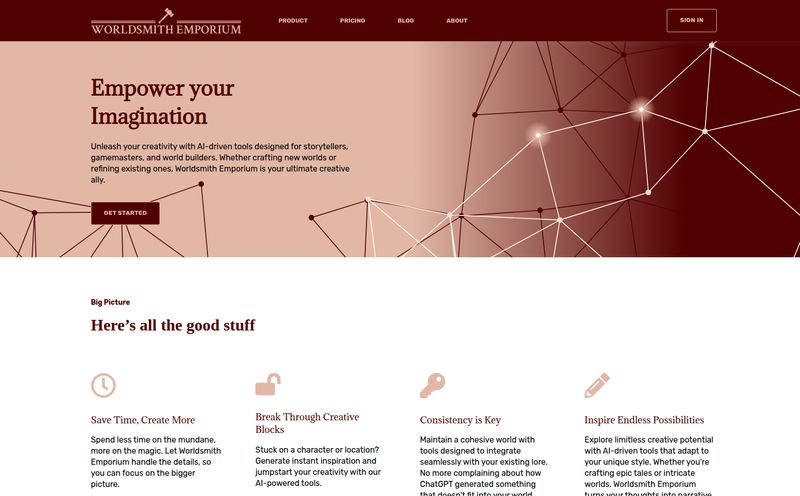I’ll admit it. I’m getting chatbot fatigue. We all are, right? Ever since the AI explosion, my workflow has become this endless, monotonous loop of typing a prompt into a little box, getting a decent-but-not-quite-right result, tweaking the prompt, re-running it, and hoping the AI finally grasps the nuance of what I’m trying to build. It feels less like a creative partnership and more like trying to explain a complex movie plot to a very literal, very patient goldfish.
It’s effective, sometimes. But is it inspiring? Rarely.
Then something different landed on my radar. A tool called Minduck. The tagline on its stark, minimalist homepage caught my eye: “Use AI With Your Mind.” Not with a chatbox. Not with a command line. With your mind. Now that’s a bold claim. It promises a shift away from the conversational churn and toward something more intuitive, more structured, more… human. I had to see what this was all about.
What Exactly is Minduck? Breaking Down the Concept
So, what is Minduck? At its core, Minduck is a web-based AIGC (AI-Generated Content) platform that throws the chat interface out the window. Instead of typing conversational prompts, you build a mind map. You start with a central idea and branch out, creating nodes and connections that visually represent your thought process. The AI then reads this structure—this map of your logic—and generates content based on it.
Think about it this way. Asking a chatbot to write a marketing plan is like describing a house you want to build over the phone. You can be descriptive, but details will get lost. Using Minduck is like handing the AI a detailed architectural blueprint. Every room, every connection, every structural element is laid out. The AI doesn’t have to guess your intent; it can see it.
This fundamentally changes the interaction. You're not just telling the AI what to do; you're showing it how you think. Its a platform where your unique logic merges with the raw generative power of artificial intelligence.

Visit Minduck
My First Impressions: Getting Hands-On with Minduck
Loading up Minduck for the first time is a unique experience. My fingers instinctively went searching for the prompt box. Where do I type my request? It took a moment to de-program my brain. There is no box. There is only the canvas.
For anyone who isn’t a die-hard mind mapper, there’s a small learning curve. Not in using the tool itself—it’s very intuitive, just click and branch—but in shifting your thinking. You have to stop thinking in sentences and start thinking in concepts and relationships. But then, the “aha!” moment hits. I started mapping out a content strategy for a client, with main topics branching into sub-topics, which then branched into specific article ideas, keyword clusters, and target personas. It was all there, on one screen. Clear. Organized.
Instead of feeding a list of keywords to a chatbot and hoping for the best, I had built the logical skeleton of the entire campaign. The AI could then flesh out any part of that skeleton on command, because it understood the context of the entire structure. That’s when I realized the power here. It’s not just about generating text; it’s about co-creating a structured project with an AI partner.
Who Should Be Using This? (And Who Might Want to Wait)
This kind of tool isn't a silver bullet for everyone, but for certain people, I think it could be revolutionary.
The Dream Users: Creators, Educators, and Teams
I immediately saw the potential for a few key groups. For content creators and marketers, this is a brainstorming paradise. You can map out an entire YouTube series, a multi-platform social media campaign, or a pillar-and-cluster blog strategy visually. The AI can then help generate scripts, posts, or drafts that perfectly align with the structure you built.
For educators and students, the applications are just as exciting. Imagine a teacher creating a lesson plan mind map and having the AI generate student handouts, quiz questions, and summary notes for each section. Or a student mapping out a research paper, with the AI helping to organize sources and draft sections based on their logical flow. It’s a powerful way to externalize and build upon an argument.
And then there’s teams. Minduck mentions real-time collaboration, and this is where it could truly shine. Having a whole team contribute to a single, evolving mind map for a project launch or a software build is already powerful in tools like Miro. But adding an AI that can execute on the collectively-built plan? That's a whole new level of collaborative productivity.
A Note for the Chatbot Power Users
Now, let's be fair. Some folks are absolute wizards with text prompts. They’ve perfected the art of whispering to the machine and can coax incredible results from a standard chatbot. For them, this might feel like a step backward or an unnecessary complication. If your brain is wired for linear, conversational prompting, Minduck will require an adjustment. It's a different muscle, and not everyone will want to flex it.
The Good, The Bad, and The... Coming Soon
So let's break it down. What I love about Minduck is that it genuinely simplifies AI interaction for visual thinkers. The promise of “no AI skills needed” is pretty close to the mark. If you can make a list, you can make a mind map. It’s a much lower barrier to entry than mastering the dark arts of prompt engineering.
The main drawback, if you can call it that, is twofold. First, the learning curve for non-visual thinkers is real. Second, the platform's own materials mention that “Visionary features are coming soon.” This is both exciting and a little frustrating. It means the tool we see today isn't even the final form, which is awesome. But it also means we're getting a taste of a promise that isn't fully delivered yet. I'm incredibly curious to see what these visionary features are.
What About the Price Tag?
This is the million-dollar question, isn't it? As of my time with the tool, there’s no public pricing information available. The site prominently features a button to “Enter the Free Trial,” which is exactly what I did. This suggests we're likely looking at a future subscription model, possibly a classic freemium structure with limited maps or features for free and unlimited power for paying users. For now, you can get your hands on it without opening your wallet, which is the best way to see if its visual approach clicks with you.
Minduck vs. Traditional Mind Mapping Tools
You might be thinking, "I already use a mind mapping tool. What's the difference?" It's a great question. Tools like MindMeister or Coggle are fantastic for organizing your own thoughts for your own understanding. They are digital whiteboards. Minduck is different. It’s an interactive blueprint. This is the core difference: you’re not just organizing ideas for yourself; you’re organizing them as a clear instruction set for a powerful generative AI. The mind map isn't the end product; it's the engine.
Frequently Asked Questions about Minduck
- Do I need to be an expert in mind mapping to use Minduck?
- Not at all. The interface is simple. If you can create a bulleted list, you can create a basic mind map. The complexity comes from your own ideas, not the tool itself.
- Is Minduck just for writing articles?
- No, it's a versatile AIGC platform. You can use it to structure and generate anything from marketing plans and video scripts to code outlines and study guides. The output depends on the structure you create.
- How is this different from using ChatGPT?
- ChatGPT is conversational. You have a back-and-forth dialogue. Minduck is structural. You build a visual map of your logic, and the AI interprets that entire structure for a more holistic and contextual output.
- Can I work with my team on Minduck?
- Yes, Minduck supports real-time collaboration, making it a potentially powerful tool for teams to brainstorm and execute projects together.
- Is Minduck free to use?
- Currently, Minduck offers a free trial. Official pricing and subscription tiers have not been announced as of this writing.
- What is AIGC?
- AIGC stands for AI-Generated Content. It refers to any text, image, audio, or video created by an artificial intelligence system, which is precisely what Minduck helps you do.
So, Is Minduck Worth Your Time?
After spending some quality time with it, my answer is a resounding yes—with a small asterisk. If you are a visual thinker, a planner, a strategist, or anyone who feels constrained by the linear nature of a chatbox, you need to try Minduck. It could very well be the missing piece in your AI toolkit.
It’s not going to replace chatbots entirely. They have their place for quick questions and simple tasks. But for building complex, structured projects, Minduck presents a compelling, and frankly, more logical alternative. It's a glimpse into a future where AI interfaces are more diverse, more intuitive and better aligned with the beautiful, messy, non-linear way our own minds work. And I, for one, am here for it.
Reference and Sources
- Minduck Official Website
- Nielsen Norman Group on Visual Thinking Strategies
- Forbes article on the state of AI-Generated Content (AIGC)



